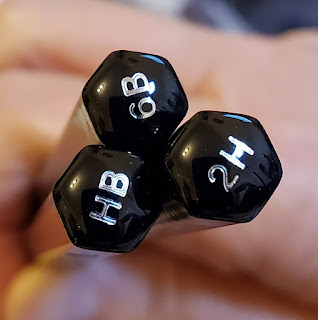 |
| Mitsubishi 9800DX graphite drawing set |
My long-time favorite graphite drawing pencil is the Mitsubishi Hi-Uni (with the Tombow Mono 100 a close second). So much so, in fact, that I rarely feel a need to check out other graphite pencils. OK, we both know that’s a lie – I do check out other pencils anyway – but no matter where I stray, I always come back to Hi-Uni.
Mitsubishi’s lower-end 9800 line has many fans, but I had always thought of it as a good-quality but basic pencil that came in only a few writing grades. Then a 9800DX set came to my attention – two sets, in fact – with grades from 10B through 8H! For less than half the cost of Hi-Uni, it was worth a try.
The sets I found on eBay cover two grade ranges: the full 10B through 8H set and the smaller 6B through 4H set. Resisting the urge to have all of everything, I chose the smaller set, which I knew would cover any drawing range I would ever have use for. (Yes, I did resist!) Shipping directly from Japan, it arrived within a week or so (that’s faster than many domestic orders these days).
 |
| End caps with grades! |
 |
| What a relief not to have to put up with immature pencils! |
Stillman & Birn Epsilon sketchbook, which has a relatively smooth surface.)
 |
| Excellent performance; slightly less smooth. |
My first test of the 9800s was on homework for my tree-drawing class. I made the bottom half of the drawing with my familiar Hi-Unis and Tombows. Then the next day I used the same grades in 9800s (H, B and 4B) to finish the rest of the drawing. While I did notice the slight difference in smoothness compared to both the Hi-Unis and Tombows, the graphite performed just as well as the higher-end pencils.
 |
| 2/22/21 Mitsubishi 9800 in Stillman & Birn Epsilon sketchbook |
Another day I used the 9800s in grades H and 4B to sketch the garlic (yes, it’s the same head I’ve been sketching for months; it’s so perfectly petrified now that I can probably sketch it indefinitely).
Aside from the smoothness, the main difference between the 9800s and the Hi-Unis is in “hand feel”: The Hi-Unis must have an additional coat of lacquer or two, because the hexagonal edges and the whole barrel feel more luxe and cushy. But the 9800 gets big bonus points for the handy graded end cap.
I would easily recommend the 9800DX set to an art student who wants high-quality graphite in a solid, functional grade range but isn’t ready to spring for Hi-Uni’s premium price. The only caveat is that replacement singles don’t seem to be available in the U.S. However, JetPens carries the standard writing grades by open stock (without graded end caps) and by the dozen. I’ve seen them on Amazon by the dozen, too.




No comments:
Post a Comment